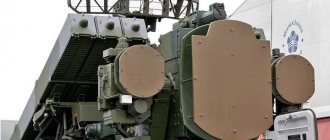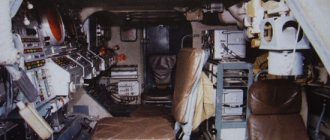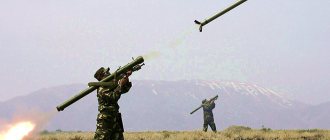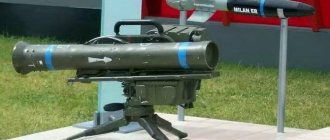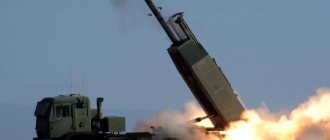American Patriot air defense system. Damage range. Compound. Rockets
The MIM-104 Patriot surface-to-air missile is designed primarily to combat ballistic missiles, intercepting them in the air. At the same time, it should replace the Nike Hercules and HAWK systems. Research on the Patriot system began in the 1960s, and in 1975 a successful target interception was made.
SAM Patriot - video
A year later, the program, first called SAM-D, was called the Patriot Air Defense Missile System. In 1988, the capabilities of the Patriot system expanded - now it began to hit not only aircraft, but also missiles. The missile is launched from a highly mobile launcher mounted on an M860 trailer towed by a NEMTT Dragon Wagon tractor; The preparation time after the march for shooting is about 45 minutes. The system was successful during Operation Desert Storm, protecting Israeli and coalition airspace from Iraqi Scud missiles. The Patriot system can fire eight different types of missiles. One of them, PAC-2, is equipped with a solid propellant rocket engine, weighs 900 kg (1,984 lb) and has a range of 160 km (99 mi). Modifications to the system carried out in the 1980s and 1990s included new on-board computer programs, a more efficient radar, and changes to the missile design.
Composition of the Patriot air defense system
- control point (battery command post) AN/MSQ-104 - multifunctional radar station (radar) AN/MPQ-65 (entering service instead of AN/MPQ-53) - up to eight launchers (PU) M901 - anti-aircraft guided missiles MIM104 ( MIM104C for modification PAC-2) - AN/MJQ-20 power supplies
communications equipment of the complex - radio relay stations AN/MCR-137 - antenna-mast devices (maximum height 30.5 m)
auxiliary operational equipment - transport and loading vehicles (M819 tractor with a crane and an M269A1 semi-trailer with four TPK) - a mobile maintenance station on an M814 chassis with a generator located on a trailer - a vehicle for transporting small-sized spare parts - an M819 tractor with a crane and a semi-trailer for large spare parts
— means of radio engineering and tactical camouflage (as part of a division of six batteries)
Missile guidance station with phased array of Patriot air defense system
Tactical and technical characteristics of the Patriot air defense system
— Years of development: 1963 — 1976 — Start of testing: 1976 — Adoption into service: 1982
MIM-104 missile
— Rocket diameter: 410 mm — Rocket length: 5310 mm — Stabilizer span: 870 mm — Rocket weight: 912 kg — Rocket weight in TPK: 1696 kg — Warhead weight: 91 kg
Max. flight speed: no more than 1700 m/s missile 1800 m/s target - MIM-104A/B Mach 3 - MIM-104C Mach 5 (PAC-2)
Destruction range of the Patriot air defense system
- minimum 3 km - maximum for a ballistic target: 20 km (MIM-104C/D/E) - maximum for an aerodynamic target: 80 km, maximum 100 from the radar, taking into account the removal of the division and launcher.
Destruction height of the Patriot air defense system
— minimum 0.06 km; — maximum 24/25 km
— Max. lateral overload: 30 g — Flight time: 8.3-17 s — Engine operating time 11.5 s — Thrust more than 11 t — Number of missiles on launcher: 4
Technology competition
It is easy to see that the Russian-developed anti-aircraft complex in question is significantly superior to its American competitor. In all major technical and combat characteristics, the S-400 has significant advantages over the MIM-104 Patriot PAC-3. First of all, this is expressed in a greater target detection range and a greater missile flight range.
In defense of the Patriot, it should be noted that its modification PAC-3 has been in service since the late nineties, while the S-400 began to enter service only in the second half of the 2000s. However, the biggest difference in age cannot explain such a serious lag in characteristics.
M-901 launcher of the Patriot PAC-3 complex on duty, February 2013 Photo: US Army
The version about other requirements imposed by the customer seems much more logical. The US Army probably does not see the point in object-based air defense with a firing range of hundreds of kilometers. Indeed, American geography and strategy in certain situations make it possible to get by with shorter-range systems. This version explains the lag in characteristics, but still leaves the question of the ability of the US industry to create a complex of the S-400 level.
Photo of Patriot air defense system
Mobile missile launcher of the Patriot complex for 4 missiles
Similar
ZSU-23-4 Shilka. Rate of fire. Armament. Dimensions. Weight
S-75 air defense systems Dvina, Desna, Volkhov. Compound. Rockets. Damage range
ZRPK Pantsir-S1. Armament. Price. Detection range
S-350E Vityaz air defense system. Compound. Rockets. Damage range
OSA-AKM air defense missile system. Firing range. Rockets. Compound. Dimensions. Weight
ZSU 2S6M Tunguska-M. Damage range. Rockets. Compound. Dimensions
ZRK 2K12 KUB. Damage range. Rocket speed. Principle of operation
SAM Buk-M1-2. Detection and destruction range. Rockets. Possibilities
SAM S-200 Angara, Vega, Dubna. Damage range. Compound. Principle of operation
MANPADS 9K310 Igla-1. Damage range. Weight. Possibilities
SAM 9K331 Tor-M1. Damage range. Rocket. Principle of operation
MANPADS Verba. Damage range. Rocket. Composition of the complex
SAM S-125 Neva (Pechora) Range and height of destruction. Rockets
S-400 Triumph air defense system. Damage range. Rockets. How does it work
SAM 9K35 Strela-10. Damage range. Modifications. Rockets
SAM S-300PMU2 Favorite. Damage range. Compound. Rockets
SAM S-25 Berkut. Range and altitude of damage. Rockets
SAM Sosna. Armament. Damage range. Rockets. Compound
American Patriot air defense system. Damage range. Compound. Rockets
Naval air defense missile system Dagger. Damage range. Compound. Rockets. On what ships is it installed?
ZRK 2K11 Circle. Damage range. Modifications. Compound
Anti-aircraft gun ZSU-57-2. Armament. Dimensions. Booking
KTPU "Gibka" (3M-47) Damage range. Rockets. Principle of operation
"Osa-M" - shipborne anti-aircraft missile system
MANPADS 9K34 "Strela-3"
FIM-92A Stinger - American MANPADS
S-300V (9K81) - anti-aircraft missile system
9S482M7 (PU-12M7) - battery-operated mobile control station
SAM "Avenger" - American mobile anti-aircraft missile system
MANPADS 9K32 "Strela-2"
SAM M-1 "Volna" (4K90) - ship-based anti-aircraft missile system
MD-PS - anti-aircraft missile system
ZSU-37 - self-propelled anti-aircraft gun
Commercial potential
Initially, the Patriot and S-400 were created for the needs of the American and Russian armies, respectively, but were soon able to become the subject of export contracts. Modern anti-aircraft missile systems have high performance and are therefore of interest to foreign customers. However, they are distinguished by a considerable price, which makes buyers think twice. And yet, both the S-400 and the Patriot PAC-3 managed to get into foreign armies.
Launcher during deployment to position Photo: US Army
Back in 2015, an agreement appeared for the supply of several S-400 regiments to the People's Liberation Army of China. The Russian defense industry was loaded with domestic orders, and therefore the first export complexes were shipped only this year. At the same time, back in 2016, two divisions went to the Belarusian army.
Several countries also want to order Russian air defense systems. According to officials and the press of various countries, the S-400 may go to India, Iraq, Morocco and Turkey. Previously, Saudi Arabia showed interest in this complex, but later it refused to negotiate, citing the sanctions of its allies against Russia.
Since the early eighties, the United States has supplied Patriot air defense systems to various foreign countries, primarily from NATO. Most of these countries have now adopted a modern modification of the PAC-3 complex, but some armies still have older PAC-2s. New systems are available in Germany, Israel, Kuwait, the Netherlands, South Korea and Japan.
Patriot PAC-2 missile launch, February 11, 1991. Anti-aircraft gunners attacked three enemy Scud missiles, but destroyed only one in the air. Photo: Israeli Government Press Service
Turkey could have become an operator of the Patriots, but several years ago Washington refused to supply it. Moreover, the United States threatened Ankara with problems in the field of military cooperation if it buys Russian or Chinese complexes. The Patriot PAC-3 is expected to be delivered to Poland, Romania and Sweden in the future.
The argument about the difference in age of the two complexes was irrelevant when comparing technical characteristics, but it is still worth remembering when studying commercial successes. The Patriot PAC-3 air defense system had more time to interest foreign customers and enter their armies.
We should not forget about the political side of military-technical cooperation. The United States has the ability to put pressure on its allies who are bound by certain obligations. In addition, some buyer countries may have difficulty purchasing and integrating any weapons other than American ones.
Launch of ERINT interceptor missile Photo: US Army

